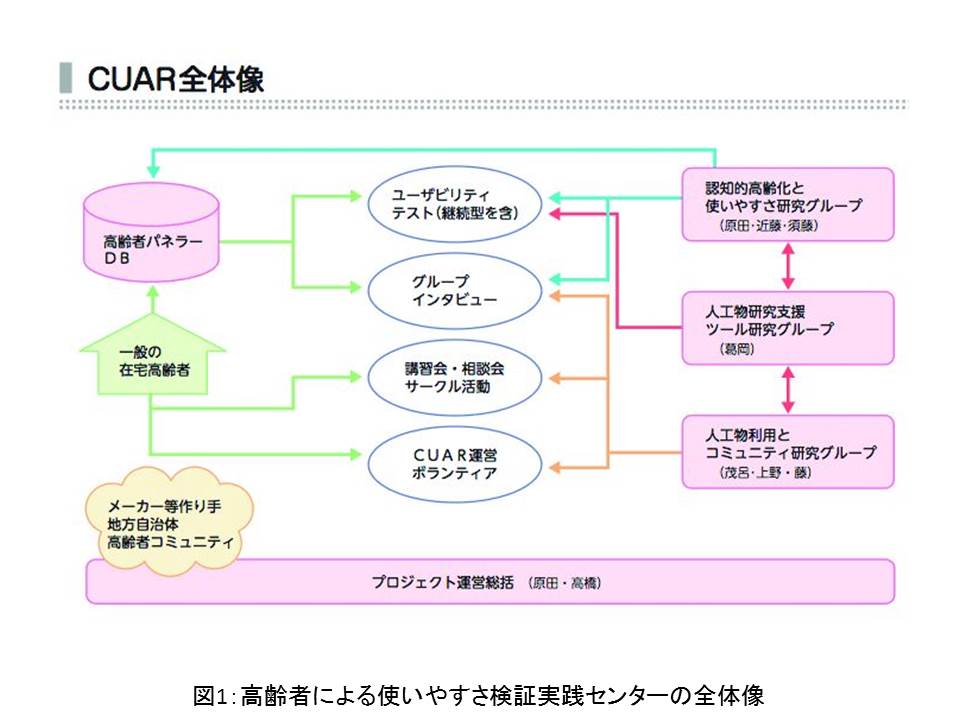キーワード:認知的高齢化、使いやすさ、人工物とコミュニティ、人工物デザイン、遠隔支援
http://tsukaiyasusa.jp/project/

現在の日本は急速な高齢化と情報化が並行して進行しています。だれもが新しい情報技術を使って快適に生活できるようにするには、どのような形にするのがよいのでしょうか?この課題に取り組んでいるのが「CUAR-みんラボ」リサーチユニットです。本ユニットでは、地域の高齢者にユーザーの代表として調査研究に参加してもら うことで、「モノ」の使いにくさを総合的に検証しています。これらの研究の積み重ねにより、モノをデザインする時から「使いやすさ」を組み込むことを目指 しています。
使いにくさを徹底的に検証する
「モノ」というと実際に手に取れる製品を想像しがちですが、私たちは使うことを目的として人が作ったものすべてを「モノ」と考えています。たとえば、 PASMOやSuicaなどの電子マネーは、?手に取れる「モノ」としてのカードのほかに、?目には見えない「モノ」として法律や社会システム、インフラ 整備が関わっています。この2つの組み合わせが正しくデザインされているとき、私たちは「タッチだけで」買い物ができるのですが、デザインが悪いと使いに くかったり事故がおこったりします。とくに、近年急速に発展してきたICT*1機器*2の使いやすさは、製品のデザインと裏で動いている社会システムの2 つが大きく影響しています。使いやすい形を追求するために、まずは、人が作ったモノの使いにくさを、メンバーのそれぞれの専門領域(認知工学・ユーザ支援 工学・学習心理学など)から総合的に検証しています(図1)。

高齢者=使いにくいところを上手に取り出してくれるエキスパート
使いにくさの検証は、学外に設置した「みんなの使いやすさラボ(略称:みんラボ)」を中心に、県南地域にお住まいの高齢者の方に協力していただいておこ なっています(図2)。これは、高齢者特有の事例を調査したい、という理由からではなく、私たちが、高齢者をユーザーの代表として考えているためです。こ れまでの研究から、高齢者がエラーを起こす場面と、若年が戸惑いながら何とか使っている場面は共通ということが明らかになりました。ユニバーサル・デザイ ンという言葉に表されるように、悪いデザインのモノは誰にとっても使いにくいのです。使いにくいところを上手に取り出してくれるエキスパート=高齢者と タッグを組んで研究を進めているところです。

社会への貢献・実績
● 研究参加者データベースの構築、および登録会員を対象にした、みんラボカフェ等の開催
研究参加者データベースの構築、および登録会員を対象にした、みんラボカフェ等の開催
● 社会全体に広範な広がりを持つ社会の高齢化の問題について、総合
的かつ科学的にアプローチをする場を設けることにより、社会問題
を複層的にとらえる研究活動に直接参加する機会をもたらす
● 恒常的な高齢者研究の場(みんラボ)設置による、自由な発想に基づ
く高齢者研究の促進
(図3:みんなの使いやすさラボ「みんラボ」ロゴ)
(取材:平成25年6月20日)
Scientific Studies for usability and human-artifacts interactions with older adults living in community
Key words:ognitive aging, user interface design and usability, artifacts usage and community, supporting to use remotely
 Recent years, aging of society and informatization of people’s lives are rapidly advancing at the same time in Japan. How can we make a product or a newly constructed system, which everyone can use easily and get the benefit from using?
Recent years, aging of society and informatization of people’s lives are rapidly advancing at the same time in Japan. How can we make a product or a newly constructed system, which everyone can use easily and get the benefit from using?
We, the research unit of the Center for Usability and Aging Research (CUAR), are challenging to this problem. As the base of the research, we have built the research participant database with older adults who are dwelling in local community to ask them to commit and contribute to a variety of usability researches as representative users. With those activities, we believe that we can pursue unique and effective scientific researches of human usability and artifacts design, which can be executed only in Japan
What is the usability? : From users’ view points
The word “artifacts” mean any things made by human for the human usage, like tools and machines. It might be natural to expect “artifact” to be with an entity which can be touched physically. However, artifacts are not restricted to be with a physical existence. For example, an electric money device with an integrated circuit-embedded card, such as PASMO and SUICA, have both the characteristics of a physical card, and a social and infrastructural system, which are invisible and without a physical entity. To make a good and usable e-money system which can be used to buy something from an automatic vending machine by a mere touch to the screen, we need a good interface designs for a physical card and also an invisible social system. Especially for improving the usability of Information and Communication Technology equipment (ICT devices), we need to know what kinds of problems we are facing to use those complex artifacts, which are combinations of physical and socio-invisible designs. We are trying to investigate what is usability from the viewpoints of human users and how we can make a good design for human usage, through activities of three research groups; the cognitive engineering group, the group of user support system and engineering, and the group of psychology on learning, culture, and community. (See Figure 1)

Older people are experts for detecting design problems
The Center for Usability and Aging Research (CUAR) are executing researches at the off-campus facility (See Figure 2), with cooperation of older adults who live in the southern part of Ibaraki Prefecture, who have registered to our participants’ database. We are asking older people to join the research activities, not only for making usable artifacts for older people, but also for making artifacts to be usable to all people. Based on the principle of the Universal Design, older adults are experts for detecting design problems in using, which are common for all users. With helps of registered older participants, we are now executing scientific investigations of user-interface design and human-artifacts interactions with various artifacts, e.g., from a retort pouch for food to a smart-and-advanced drive assist systems.

Figure 2; CURE, the Outer appearance
Social contributions and achievements

– Developing a research participants database with over 200 older adults, and having variety of activities with registered members, e.g., monthly held workshops called min-lab Cafe
– Doing researches of comprehensively and scientifically approaching the problem of aging in their daily lives and activities, and connecting those outcomes to develop general design principles.
– Promoting design improvements and re-designing of artifacts by manufacturers and/or service providers for universal usability, by offering facilities of CUAR in general.
